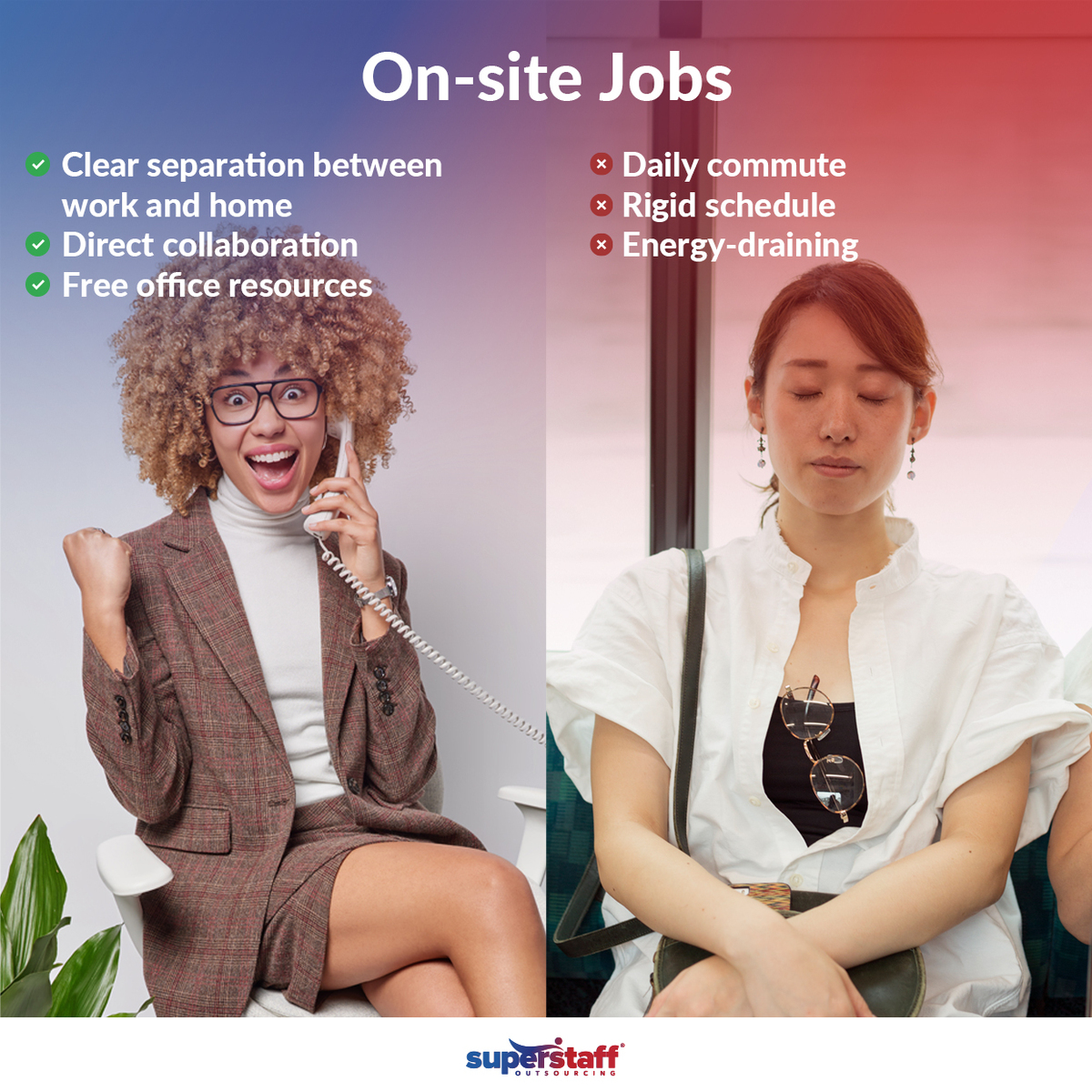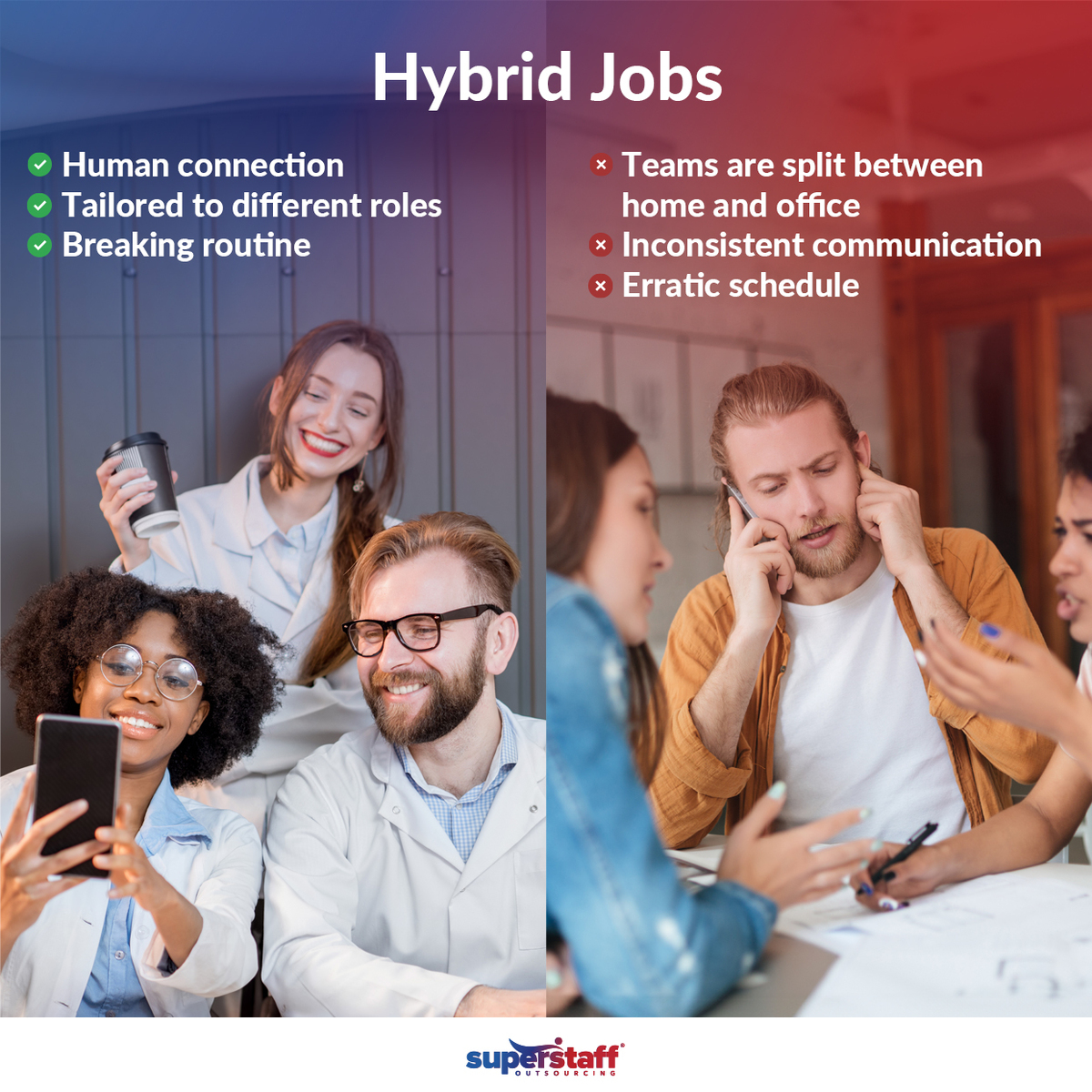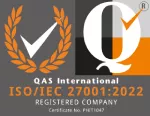
I’ve tried working from home and in an office, so if you’re torn between the two, you’re in the right place.
First off, there’s no one-size-fits-all answer. The best setup depends on your personality, circumstances, and priorities.
I started working remotely in 2012, long before the pandemic. Back then, it was mainly freelance work.
In 2021, during the height of COVID-19, I landed a work-from-home job with SuperStaff. Now, I enjoy all the perks of regular employment—health insurance, Pag-IBIG, SSS, PhilHealth, and more.
Before that, I spent most of my career working on-site, with a daily 1.5-hour commute from a small town to the city.
To help you decide on the best arrangement for you, let me explain the pros and cons of remote and on-site jobs. We’ll also explore the increasingly popular hybrid setup.
Work-From-Home Jobs
I’ve been working from home since before it was cool, but the pandemic turned everything upside down. Suddenly, everyone was setting up home offices. And, as it turns out, there’s now extensive discussion about remote work.
The Upside: You’re at Home!
Flexibility
You get to create a work schedule that fits your life. Morning person? Night owl? It’s your choice!
Cost Savings
Say goodbye to gas, bus fare, and overpriced coffee. Plus, you save on lunches and work attire.
Work-Life Balance
Balancing work and personal life becomes more manageable. Need to pick up the kids or squeeze in a midday workout? You’ve got the flexibility to do it.
I chose to work from home when I got pregnant and never looked back.
The Downside: Not All Sunshine and Rainbows
Isolation
Work-from-home jobs can get lonely. You miss out on office banter and face-to-face interactions.
Distractions
Home can be full of distractions — TV, the fridge, or that pile of laundry calling your name. Plus, family members might think they can interrupt you anytime because “you’re just at home.”
Overworking
When your home is your office, it’s tough to switch off. The line between work and personal time can blur, leading to burnout.
Working from home can be addictive, but it’s crucial to set boundaries. I’ve had great bosses who respected work hours, but I was the one who couldn’t call it a day.
Is It Right for You?
Work-from-home jobs are fantastic for those who need flexible schedules, like parents or caregivers. You’ll thrive if you’re self-motivated and good at managing your time! It’s especially great for tech professionals, writers, designers, and creatives.
Pro tip: Stay professional. Treat your work-from-home job as if you’re still in the office. Be on time and collaborate well with your virtual teammates.
Invest in your equipment — desktop, laptop, ergonomic chair, and, most importantly, a reliable internet plan. Some employers will provide a laptop or pay for your internet, but it’s worth investing in yourself.

On-Site Jobs
On-site jobs have been the norm for decades. You head to a fixed location daily, clock in, work, and clock out. Pretty straightforward, right?
The Upside: You’re With People!
Structured Environment
On-site jobs offer a clear separation between work and home. When you’re at the office, you’re in work mode. When you leave, work stays behind.
Direct Collaboration
Need to talk to a coworker? Just walk over to their desk. Face-to-face meetings are perfect for brainstorming and quick updates.
Access to Resources
Everything you need is right there — printers, scanners, and specialized equipment. No more struggling with a malfunctioning home printer or slow internet.
The Downside: Physically Draining
Public Transportation
Commuting can be a real drag. The time and money spent getting to work, especially in traffic, adds up.
In 2021, Metro Manila’s Metro Rail Transit Line 3 (MRT-3) saw about 45.6 million commuters, averaging 136,935 riders daily. Fast forward to 2023, and that number skyrocketed by over 30%, with daily ridership jumping to 357,198 from 273,141 in 2022. And that’s just the MRT!
Motorcycles dominated Metro Manila’s roads in 2023, with an average daily traffic volume of approximately 1.67 million. Cars followed closely, contributing about 1.57 million to the total traffic volume, which reached around 3.63 million vehicles for the year.
On top of that, a separate survey revealed that 27% of Metro Manila commuters spend an average of 30 to 59 minutes commuting daily.
Rigid Schedule
On-site jobs usually have set hours, making managing personal time challenging. However, a structured schedule might not be a big deal if you love what you do.
My schedule was chaotic when I worked for a film production company, but I didn’t mind because I loved the job. The energy drain came from the daily commute.
Is It Right for You?
On-site jobs are ideal if you thrive on routine and structure. This setup is perfect if you need access to specific tools or equipment. It’s also great for social butterflies who enjoy the camaraderie of working closely with others.

Hybrid Jobs
If you love the flexibility of working from home but also enjoy the buzz of an office, a hybrid job is the perfect balance.
You get to work remotely but still pop into the office when needed. This trend is growing as companies adapt to new work realities.
The Upside: The Best of Both Worlds
Balanced Interaction
Enjoy the convenience and freedom of remote work mixed with the structure of being on-site. Regular in-person meetings keep that human connection alive.
Adaptability
Hybrid work can be tailored to different roles and personal needs, making it a win-win for everyone.
The Downside: Collaboration Across Split Teams
Challenging Inter-Departmental Collaboration
Managing schedules and communication can be tricky when teams are split between home and the office. It takes some coordination to get everyone on the same page.
Inconsistency
Maintaining productivity and engagement across both settings can be challenging. Establishing a routine is key.
Is It Right for You?
If you crave the flexibility of remote work but still want in-person interaction, hybrid is for you. It offers balance and helps manage feelings of isolation.

Choosing the Right Work Arrangement
Still wondering which work arrangement is best for you? Consider your personal needs, company culture, and job market trends.
Think about what you want. Do you love rolling out of bed and working in your pajamas? Or do you thrive on the energy of a bustling office?
Your preferences and work style matter. You may need flexibility for family responsibilities or personal commitments. That’s okay! Choose what fits your life.
Factor in company culture. Some companies are flexible and support remote work, while others are more traditional. Finding a place that aligns with your values is crucial.
Do your research on potential employers. See if they offer the support you need, whether for remote, on-site, or hybrid work. You’ll spend a lot of time with this company, so make sure it’s a good fit!
Like What You Read?
SuperStaff features articles authored by executives and industry experts, providing our readers with expert insights and valuable perspectives. Covering a range of topics, these articles offer in-depth analysis, innovative ideas, and practical advice from leaders in their fields.
By showcasing content from seasoned professionals, we strive to keep our audience informed about the latest trends, challenges, and opportunities across various industries.
Join us on this journey of growth and success. Follow us on LinkedIn and Facebook for insightful content and tips to enhance your business leadership.






